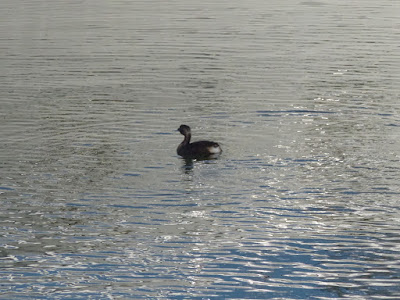All summer long I have seen flying and hovering Black Saddlebags (Tramea lacerate) over fields, ponds and even lakes if I can count Sherwood pond as a lake. I never saw one perched. Finally, this morning, I startled one as I was walking on a narrow wetland trail in the man-made wetland of Rivard Plaza in downtown Detroit.
I watched as it flew back and forth and around the wetland. It approached the spot from where I had startled it and so I backed off a bit and stood perfectly still. That seemed to do the trick because it flew in and settled in the same area.
Thinking it would be flighty I took a couple of distant shots and continued to move forward slowly. In this photo the long cerci are easily seen.
I kept thinking it would fly and was surprised when I was able to get right up to it - so close that I had to back off with my camera.
I think this dragonfly is an immature male. *Paulson describes abdomen black, often showing yellow squares on S7 indicative of immaturity.
Being able to get these photographs was thrilling and the black saddlebags did not disappoint. Its size, pattern and shape of its saddlebags and the long cerci reveal it to be a spectacular creature.
Grasshopper found a sunny perch off trail.
This T. lacerata is a different individual that perched in a drier area closer to the river. None of my photos were as nice perhaps because of the brighter sun and the kind of vegetation selected for its perch. In all, I saw three black saddlebags at this relatively contained location. There was a Wandering Glider (Pantala flavescens) flying around too, but absolutely no chance for photos. The only others were Sympetrum sp.
Monarchs were migrating through the park in large numbers. But, this is a Viceroy (Limenitis archippus) that stopped to nectar on a large white aster clump that also had a lot of honey bees.
Rivard Plaza is part of William G. Milliken State Park. The man-made wetland here definitely deserves attention especially in migration seasons. But it may be not suited to all birders or naturalists. You will share your searching with skaters, bikers, walkers, runners and, everyone's favorite, dog walkers. The area in the photo above must be the meeting spot for a group dog walk. There were twenty dogs in the area at the time of this photo and others still arriving. Later I saw them all walking together in a large group in another part of the park.
When I finished at the wetland I drove down to the marina. A single Pied-bill Grebe was diving here. I missed my best photo of the grebe when I saw it surface beneath a pile of green weeds. I got greedy with my advance and it dove again before I could get the shot.
As a bonus I saw a guy near the marina who looked like he could be playing Pokemon Go. So I went up to ask and he was. I got a little tutorial on how one catches Pokemons. After 3 misses with some muttering between his throws, "don't leave, don't leave," he finally, using a curve ball, got the one I was watching with him. For a quick follow-up he then easily caught another that looked like a fish. I'm not a gamer, but I can understand how Pokemon Go could be completely addictive. Like photographing birds or dragonflies - "don't leave, don't leave."
* Paulson, Dennis, Dragonflies and Damselflies of the East, Princeton University Press, 2011, page 510.











No comments:
Post a Comment